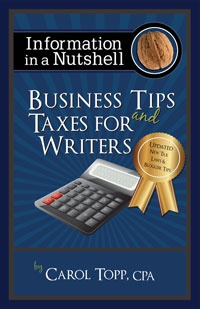Shocking News To Authors: The Book Business Is A Business First
December 10th, 2011 → 8:25 am @ Carol
Terry Whalin, author and publisher, gives us insight into the costs of publishing that most authors never see.
Before I began working inside a book publishing house, I had written more than 50 nonfiction books, ranging from children’s to adult books. I have never self-published a book and always worked through traditional publishers. However, I was unaware of the financial production numbers for nonfiction books and I found it shocking—and something critical for potential authors to understand.
The author never sees these figures for their books as the publisher doesn’t reveal them throughout the contract negotiation process. A publisher will produce these financial calculations as simply a part of good business practices. As an author, understanding this helped me see publishing as a business. Authors have huge amounts of time and emotional investment in their words. When I saw these production numbers, I understood that the publisher, not the author, has the largest out-of-pocket cash investment in a book.
Inside the publisher, the editor will gather a sales projection about how many copies the sales department believes they can sell of your title the first year. That sales figure will be used to calculate the production costs of ink, paper and binding for various amounts of printing (5,000, 10,000 or 15,000 copies).
As the initial print number is raised, the cost per book decreases. You may ask, So why not print a large volume each time? The answer is, if the publisher prints a large number of copies, then he has to store those copies in their warehouse (read cost and expense), plus make sure they actually sell those copies within a year’s time frame. The cost of tying up financial resources in storing and warehousing books that aren’t selling is large. Also the federal government taxes publishers on each copy in storage. These tax rules have forced publishers to think long and hard about how many copies of each book to print.
Inside my former publisher, we calculated the overall printing details of the book (paperback with general publishing look or hardcover with jacket) and the number of books to print before offering a book contract. In short, publishers pour a great deal of work into their books and financial projections before they call you and offer a nonfiction book contract. Understanding this process helps you see some of the reasons it takes such a long time for an author to receive a publishing contract…
Often the publisher returns to an author with whom they have already published a book. If the publisher takes a second or third book from the same author, they are investing in that author’s career and trying to build that author’s audience and market. If the author’s books are selling well, then the publisher will be eager for another project. Each week, publishers monitor sales numbers on their books to see if particular authors merit another book contract.
Many writers focus only on the creative aspects of writing a book and getting it published, but the executives inside a publishing house are business people who want to sell books and turn a profit at the end of the day. It’s a delicate balance between creating the best possible product and assuring that each product has the best opportunity to sell into the market and reach the target audience.
W. Terry Whalin
W. Terry Whalin, a writer and publisher lives in Scottsdale, Arizona. A former acquisitions editor, former magazine editor and former literary agent, Terry has written more than 60 nonfiction books including Jumpstart Your Publishing Dreams. To help writers, he has created a 12-lesson online course called Write A Book Proposal. His website is located at: https://www.terrywhalin.com/


